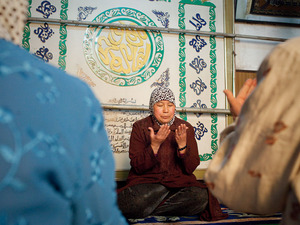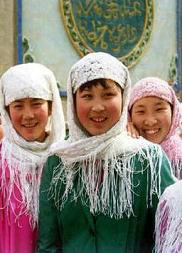Muslim Communities in Central China have female religious leaders as well as their own unique food culture.
Despite a deep historical tradition of female religious leadership beginning with Ayesha, the wife of the Prophet Mohammed, modern China is one of the only countries in which Muslim women are widely accepted as heads of their religious communities. These female religious leaders also fulfill most of the duties of imams – except they don’t perform weddings and funeral ceremonies. These female imams lead women in prayer at the women-only mosques, make passionate sermons, impart the knowledge of the Koran and even teach women to read and write in Arabic. They wash and purify the bodies of Muslim women who die, and function as advisors in religious matters for both men and women.
Many communities in Central China even have women-only mosques for female prayer and study. In other countries where women are allowed to enter mosques, their prayer is limited to separate rooms or behind screens, separated from the main area of the mosque and hidden from the eyes of the praying men.
Not so for the Hui – a Chinese ethnic group who are descended from some of the original Muslim merchants and statesmen who came to China mostly during the Mongol-led Yuan Dynasty. The original settlers were an ethnic mixture of Persians, Arabs, and Central Asian Muslims, who are ethnically and linguistically distinct from the Uyghurs and Turkic-speaking Muslims in China’s west and northwest. These settlers intermarried with Han Chinese and other ethnic groups and became known by their modern moniker – the Hui. Making up about half of China’s more than 20 million Muslims, the tradition of strong female religious leadership is a living atavism or founder-effect of the customs of the original Muslim settlers in Central China.

Gao Baogong, the male head of the Islamic Association of Kaifeng says, “Muslims in other countries feel that we go too far. It seems very strange to them that a woman acts as imam. They are mistaken, of course. Women and men should have total equality. I’m not the only one saying it. The prophet Mohammed said it in his own words.”
Why then have Muslim women attempting to take religious leadership faced discrimination and condemnation in many other Muslim communities and countries? Sure women in Morocco and in Shia Iran have some counseling and leadership authority – but it cannot even be compared to that of an imam. Were the ancestors of the Hui uniquely liberal or has the Sunni world become more conservative over the centuries? So many questions. . .
One thing for certain is that female religious leadership has not been a threat to the Hui’s faith which has persisted for over a thousand years. The Hui’s faith and customs survived even the blight of the Cultural Revolution and they remain a living remnant of the ancient Silk Road that brought their ancestors to China.
Other aspects of Chinese Muslim culture have not only survived, but thrived over the centuries as well. One such example is the unique food-culture that exists amongst China’s Muslims that blends Uyghur and other Turkic-speaking Muslim food traditions with those of the amalgam Hui peoples. Muslims in China do not eat pork, keep to halal dietary practices, and in some cases will eat only fish with scales, eschewing shellfish. Quite a few dishes now enjoyed widely in China were also introduced by China’s Muslim citizens.
For example, the Hui are credited with creating beef noodle soup, now widely enjoyed around China made of stewed beef, beef broth, vegetables and Chinese wheat noodles. The soup is flavored with salt, red chili peppers, white peppercorns, and green onions, and one glance is all you need to see the link to Central Asian lagman soups. Muslims use halal meat and generally refrain from the use of soy sauce when mixing the soup.
Another dish credited to Chinese Muslims is the salt-fermented cabbage Suan Cai which is related to the northern sweet and sour cabbage Pao cai except that it has a strong pickled flavor. It is enjoyed with soups and stews as a vegetable or topping and in the south often eaten with a congee as a meal.
The Uyghurs and other Central Asian Muslims are also said to have introduced the kebab meats (especially lamb) now popular all over China as street-food and seasoned with cumin, red chili peppers, salt and sesame oil or sesame seed. The Chinese like “dry” or shish kebabs of chunks of meat, but also fried kebabs of ground meats as well. An interesting and uniquely Chinese kebab is the steamed kebab brushed with sweet bean paste.
Fentiaozi or Emperor Salad is a complex salad of noodles, cabbage, limejuice, eggs, and soy sauce is also a dish of Muslim origin. Flatbreads called Nang clearly related to Western, Central Asian and Southern Asian naan are also enjoyed as are stuffed breads such as the Jui cai he that are stuffed with garlic chives or leeks.
In addition to female leadership in their Muslim communities, China’s more than 20 million Muslims (more than in all the Arab Muslim Gulf states combined) also have been great innovators of food in China – bringing with them dishes and food traditions from their homes in Western and Central Asia as they travelled the ancient world along the along the Silk Road. (Words by Laura Kelley; Photo of Chinese Muslim Women, Female Chinese Religious Leader and Hui Beef-Noodle Soup from Google Images.)

